Archive Monthly Archives: February 2016
What is Marketing Funnel Automation? – and How Can I Conquire it?!
In its simplest form, Marketing Automation is when a visitor requests information and receives it automatically by email.
Today, visitors request can lead into behavior-triggered email follow-up and off-site ad re-targeting that delivers specific content based on the visitors exact behavior (i.e. which pages he visited revealing both his interests and stage of the buying process).
Example Automation Workflows
This small piece of an automation workflow gives a glimpse into the possibilities with automation.
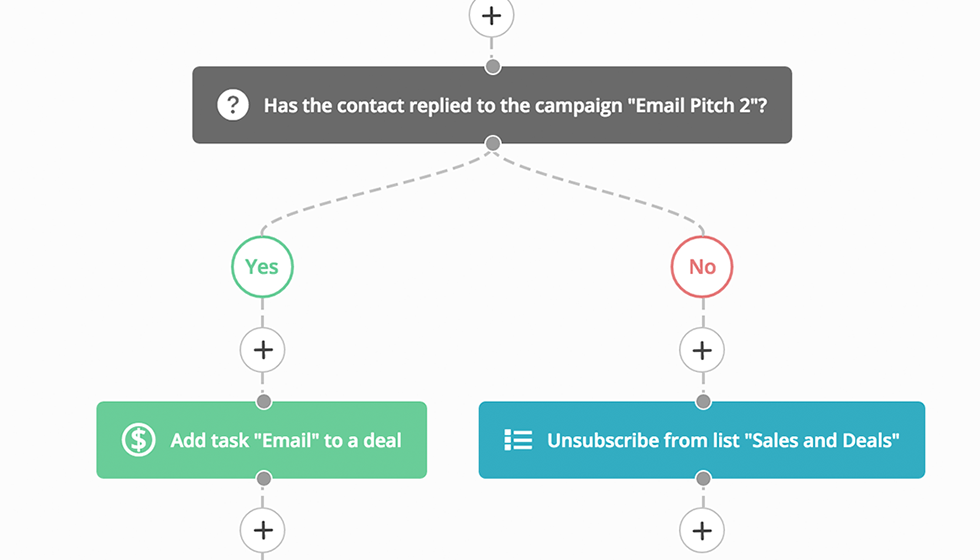
Or how about this more detailed example showing a number of conditional triggers in part of an automation workflow:
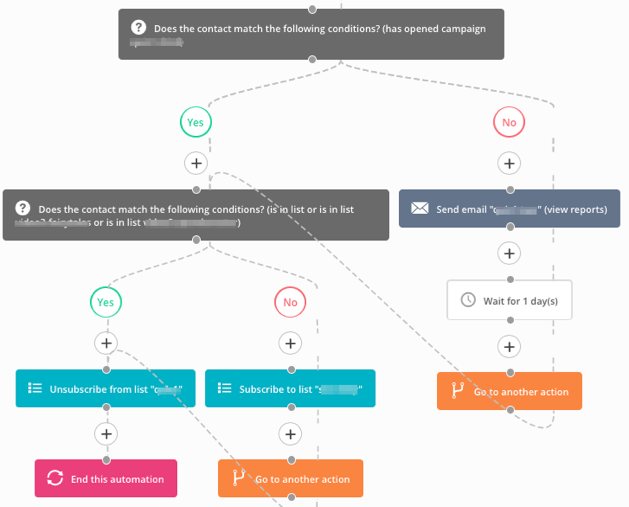
At first glance that may seem utterly confusing.
Yet, Marketing Funnel Automation is now vital to compete with the degree of personalization and the varied campaign approaches used by large businesses and increasingly by SMEs.
If you’ve previously been scared off by high fees for Marketing Automation projects you’ll be pleasantly surprised by what ITVibe can offer for optimizing contact frequency and message relevance for a better customer experience that brings the greatest ROI.
Here’s a basic customer journey example:
- Mary sees one of your ads and lands on your ecommerce page for handbags but does not buy.
- Later that day she accesses her Facebook account and low-and-behold sees a nice photo of several gorgeous handbags similar to the one she was looking at earlier.
- The advert gives her a compelling reason to click and she visits your page a 2nd time (at a cost to you of just a few cents).
- She sees an offer for interesting information about your handbag selection and decides to opt-in with her email address.
- This begins an automated process of nurture and offer emails that are scheduled based on whether she actually opens the emails, clicks particular and browses specific pages of the site.
- If she adds a handbag to the cart by way of ‘window shopping’, we can then automatically send her information about that particular handbag, nurturing her trust in the brand, keeping front-of-mind, and helping to close the sale.
It’s amazing what can be done with Automation
Marketing Automation acts as a filter for multiple conversion funnels that converge and diverge into various segmentations based on each contacts behavior.
Sometimes customers just need a gentle reminder or two before they buy, along with a little extra information that endears them to your brand, and overcomes their hesitation to buy from you.
But delivering that ‘little extra info’ at the right time is a science and art.
Marketing Automation provides the tools to make that happen completely hands-free once we’ve set it all up. And it doesn’t have to be a major project to get things started and see a clear and positive ROI.
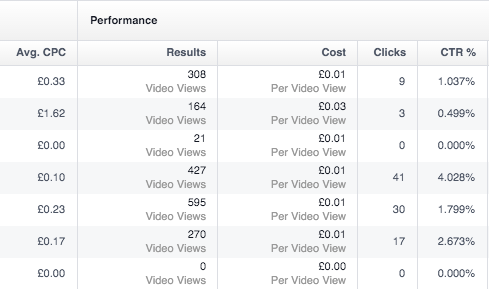
41.94% Result Rate for Pennies using Video Ads on Facebook!
Normally I can’t share fresh campaign data due to client NDAs — however, in this case I’m partners in a project and showing you our metrics is fair game!
So here’s a demonstration of how you can use micro-budget campaigns to test new marketing concepts before rolling out into broader ad spend…
The Channel of Choice
One of the most powerful methods for testing new campaign ideas, creative concepts, headlines and audience demographics is through the Facebook Advertising platform.
See the screenshot below showing results for 7 video adverts run for just a few days.
The goal is to determine the best cost/engagement ratio for video views. The column most noteworthy is for ‘Relevancy’ on the far right showing the numbers, 6, 7, 8.
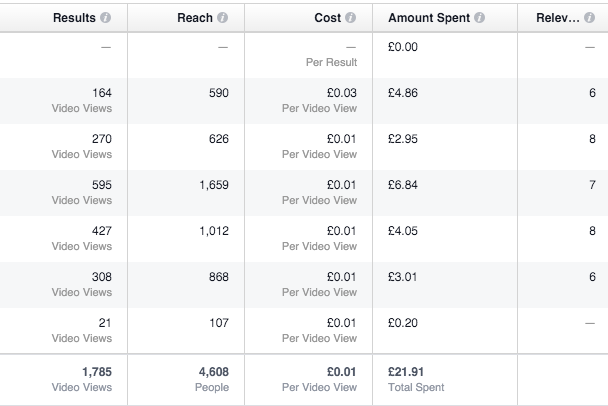
Relevancy is Facebooks assessment of how engaging each advert is for the targeted audience out of a maximum possible score of 10.
Facebook’s algorithm calculates the Relevancy Score once an advert has received 500 impressions, or ‘Reach’.
This means we can run simultaneous test ads with 500 impressions each to gauge how well the ad would perform on a larger budget to the same audience profile.
Cherry-Pick The Sweetspot Of Your Audience
If you’re unfamiliar with how granular Facebook audience targeting can be, here’s an example:

That’s 150k women age 40-50 living in one of those 5 major US cities who are interested in dating and also interested in romance novels…
Keeping It Relevant Reduces Ad Costs
Achieving a high relevancy score also means that Facebook will, over time, charge you less per view or click as they reward you with lower ad costs the more you support a positive user experience for Facebook members. Think about it.
Keep It Simple
I didn’t run all 7 ads at once. That would be overkill. Best to test 2 or 3 concepts at a time and then refine and advance based on results.
The first adverts I ran hit a 6 and a 7 for Relevancy. That gave me direction for the next mini-test (each taking less than a day to run) and so I hit another 6 plus two 8’s.
The next test will focus on the similarities and differences between those adverts to help identify new ideas to test and increase the Relevancy score as much as possible for this particular campaign and audience.
How well does this correlate with click-through rate?
Just 0.5% CTR on one of the original concepts with a massive increase hitting 4% CTR for the best performing ad.
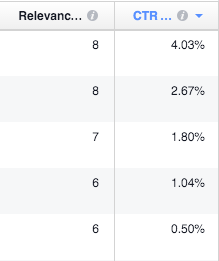
I’m not saying you need to get a Relevancy Score of 8 or that you’ll then see a 4% average CTR. Just that the correlation of Relevancy with CTR is demonstrably evident. My goal for this campaign is Relevance Score 9 with 8% CTR.
Such metrics are always useful for presenting to budget approvers, in team meetings and end of month results meetings. Especially when you show highly cost-efficient due diligence of innovative new marketing concepts to build support for bigger budget approvals.
In this way we can validate ideas for new marketing campaigns. And while it’s still early days on this particular campaign, it’s gratifying to see CTR go up 706% within just a few days, 2 test iterations and pocket change.
Facebook Is The Perfect Channel For Testing
Below includes a column for ‘Result Rate’ which in this case is the percentage of people who watch at least 10 seconds of the video advert once it shows up on their Facebook News Feed.
+40% of people watching more than 10 seconds of an ad that is costing pennies to deliver shows the incredible opportunity of Video Advertising on Facebook today.
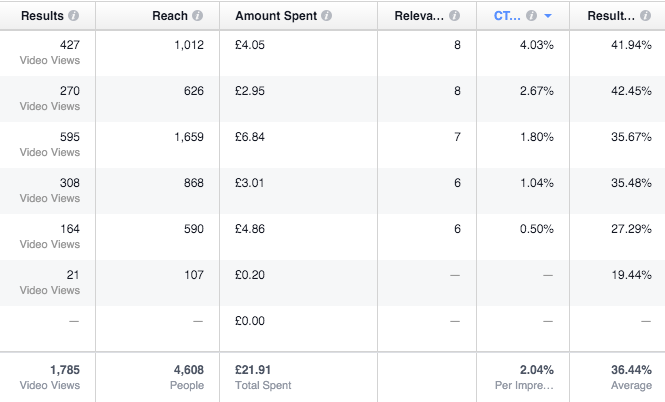
And here shows the reduction in overall Cost Per Click with increase in Relevancy, CTR and Result Rate.
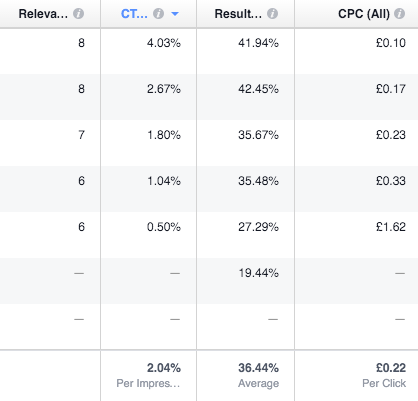
From £1.62 CPC down to £0.10 CPC. A 93.8% reduction!
Could that difference turn a highly unprofitable campaign into a profitable one? Of course…
Next steps for this campaign is to start tracking it from the click through to confirmed lead generation (and therefore measure Cost Per Lead). Brand engagement can be tracked in various ways although I prefer measuring opt-in rate as a KPI for brand engagement for trackable campaign funnels.
From there I can track individual ads through to sales and thereby calculate ROI down to the penny.
But where to focus?
If you’ve ever seen a car mechanic tighten the bolts on a wheel you’ll see he rotates around them, tightening them a little each time.
Why? Because if he tightened one of the bolts fully without ensuring the others are aligned, he might actually get the bolt stuck rather than securely fastening the wheel.
And it’s the same with campaign testing.
With the above results I can introduce elements from winning ads into the landing page and subsequent email nurture campaigns leading to sales.
However: We don’t want to invest lots of time and effort across all parts of a conversion funnel while still establishing what works best for a particular campaign (including segmentation, offer, headlines, etc).
Update: On the next round of micro-tests the campaign has achieved Facebook’s highly coveted maximum Relevancy score of 10, with a 8.59% click-through-rate at just 0.13 average cost per click! Time to optimize the next step in this sales funnel.
![]()
Your Next Steps
It’s so easy to start testing concepts and exploring ideas, hunting for the next blockbuster winner that could become key to your growth strategy in the year ahead.
If you don’t have the expertise or capacity in-house for this type of project, and would like to get the ball rolling with minimal effort, I can create campaigns that meet your brand guidelines and get them running for you very fast. Most likely for far less investment in resource or ad spend than you would get in-house or with a traditional agency.
Send an enquiry today and let’s find a few winning concepts that you can roll-out across your marketing.
6 Split Tests to Validate Your Marketing Spend
“Yes, but who has time for creating two versions of everything when there’s barely enough time for one!”
I understand.
Yet the cost/benefit ratio is mind-blowing when you really grasp the effects and experience the results of split testing in your own metrics.
And there are fast and easy ways to make testing super streamlined, including: knowing where the weakest conversion point in your funnel exists and focusing optimization efforts there, or hiring the likes of yours truly to do the grunt work for you.
Fist…
…here’s a selection of split-test results from projects I’ve done over the past 8 years for each of the major KPI conversion points in a fairly typical online sales funnel.
Test 1: Cold Traffic Clicks
Test 2: Landing Page Click-Throughs
Test 3: Cold Traffic Lead Generation
Test 4: Sales Page Conversions
Test 5: Email Nurture Campaigns
Test 6: Repeat Customer Sales Campaigns
Test 1: Cold Traffic Clicks
In my recent post “41.94% Result Rate for Pennies using Video Ads on Facebook!” you see how fast we can validate innovative and creative campaign ideas with results like these:

Key learnings you glean from simple split-tests on pay-per-click platforms can then be rolled out to other traffic channels and across your sales funnel.
Next up is the landing page itself.
Test 2: Landing Page Click-Throughs
This graph shows the click-through rate of a pre-sell article lander for the five variants tested.
The difference between the best performer at 37% and the worse at 24% can drastically increase campaign results and reduce ad spend.

Below are two variations from a multi-variate test looking at the best heading, sub-head and background design to use in combination.
Which of these two variations would you choose as the winner?
Variation 1:
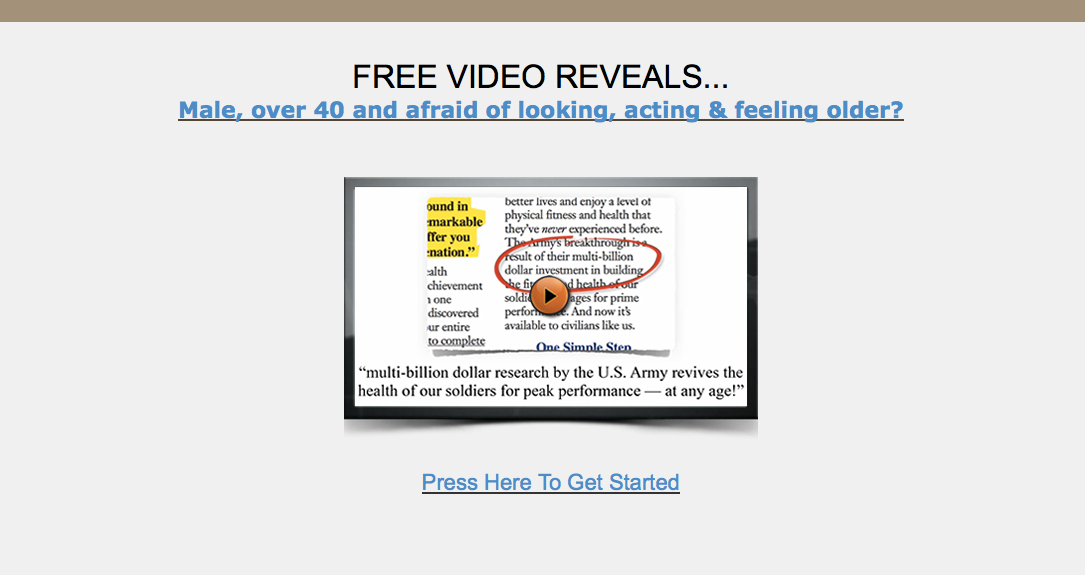
Variation 2:
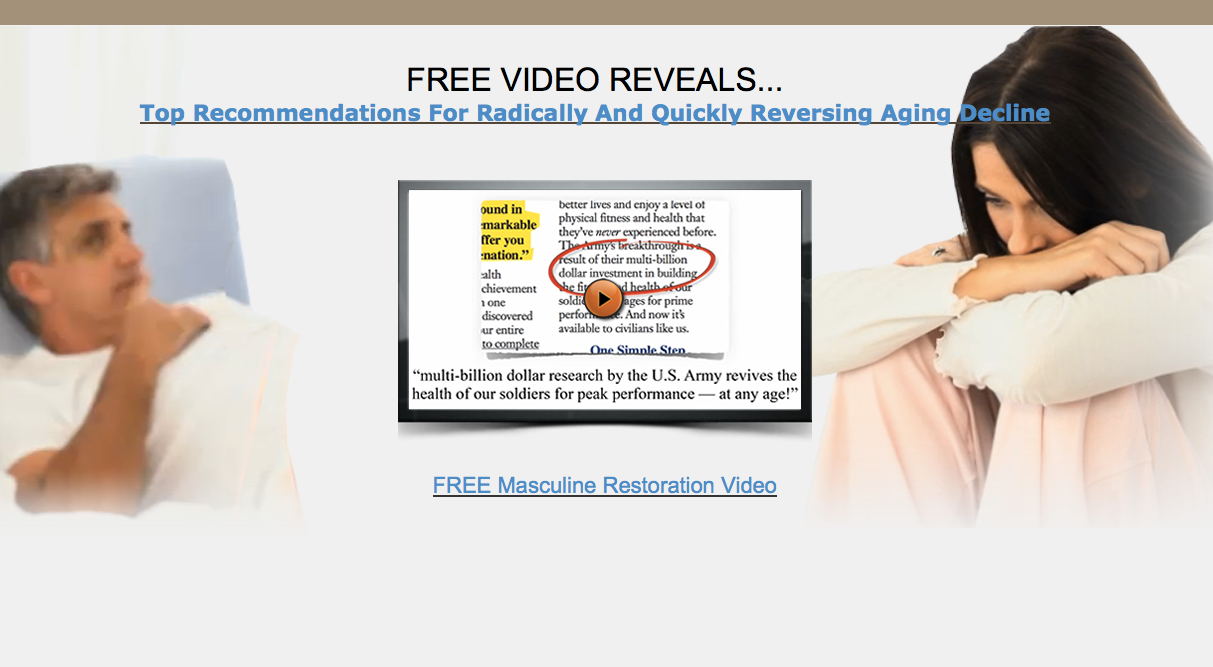
The winner was number 1 by quite a margin. Further tests pinpoint exactly why, which led to new insight about the target audience.
Yes, the design seems quite poor. I worked with the clients designer who had a lot on his plate. It was enough to validate the first test variants before investing more attention on graphic treatment for subsequent tests and broader roll-out.
Below shows that same split test campaign while in progress, revealing the likely winning test variants and the best overall combination of factors.

Of course:
‘Landing pages’ is a catch all term for the likes of product review pages, blog articles, service descriptions, etc and may include a specific component for lead generation, or a click through to another page for further details.
As we increase the responsiveness of landing pages we can then directly focus on lead generation as per Test 3.
Test 3: Cold Traffic Lead Generation
I’ve seen dozens of styles of landing page that convert really well, or not at all.
It’s all about the ‘message to market match’ which can be split test with ease and presented even in the simplest of designs.
Here’s an example opt-in page by the very savvy marketers at Motley Fool (Financial News & Investing). The visitor clicks a text-heavy banner on a news page and comes to this page without much graphical treatment (or even copy) to speak of.
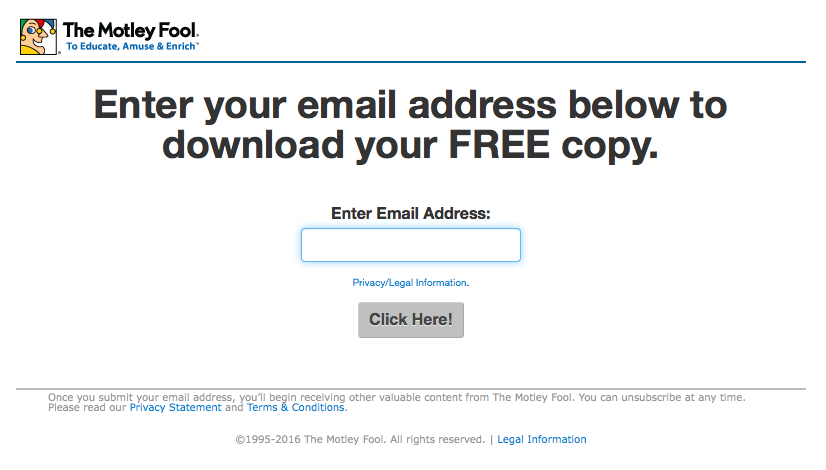
Sometimes less is more.
Here’s one our designs (with a rather provocative headline) for a ‘launch sequence 2-step video opt in page’ (meaning that it hints at upcoming content, has a video on the page, and requires the person to click a button which reveals the email opt-in form).
All of which are factors that can dramatically increase opt-in rates.
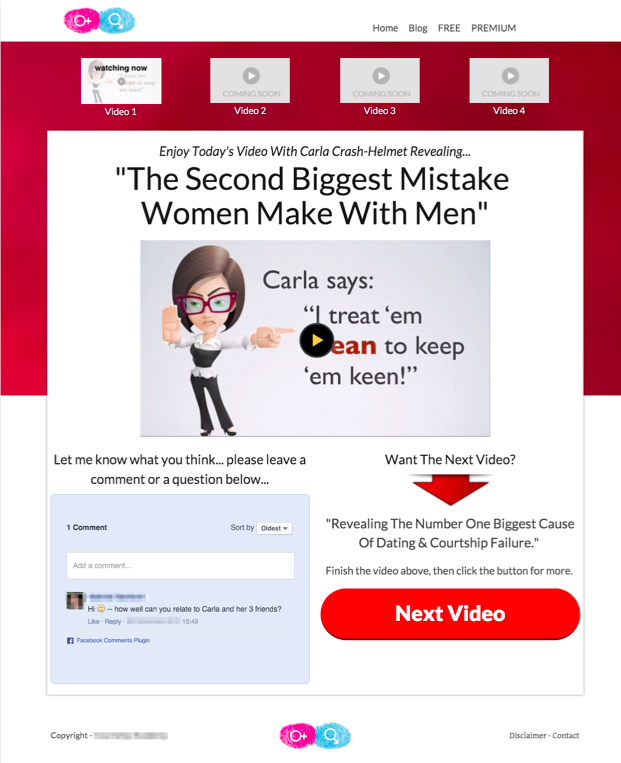
It may work better with or without the top menu navigation, or without the comments feature. Both of which are things to test!
I’ve seen some opt-in page split tests at 15% vs 40% opt-in rates. Testing on a small scale before major roll-out is often prudent.
Table shows opt-in rates for lead gen campaigns I built for various clients.
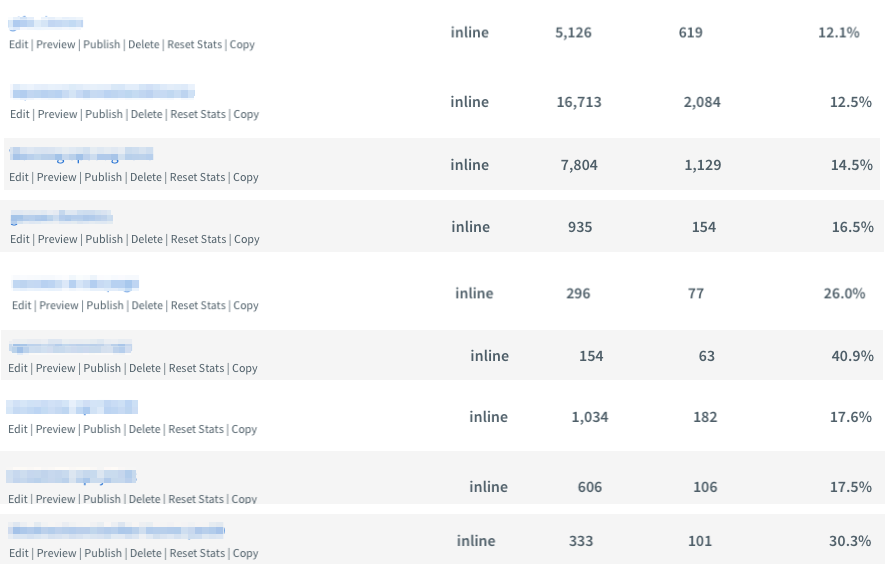
Here’s a new opt-in campaign just launched
The first version had zero opt-ins after some 50 impressions. Didn’t seem worth letting that continue. So I re-thought the opt-in offer, design and process (took like 30 minutes) and hey presto, we have lift off with the first opt-ins coming in within minutes at a good opt-in rate for both of the split-test versions as shown:
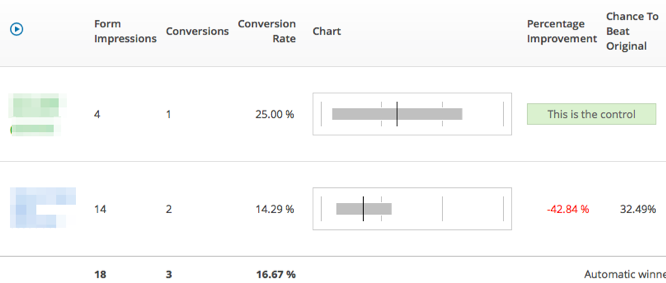
I’ll let this one run and update once we have a statistically significant number of impressions to conclude the true opt-in rate.
Next up:
Test 4: Sales Page Conversions
I re-wrote the entire introduction section of a long ‘video sales letter’ for a health supplement which resulted in a very significant increase in viewer engagement.
See the colored screenshots taken from the video analytics software.
Original lead variant: 25% retention past the introduction

My new lead variant: 44% retention past the introduction

This meant the new start of the video increased engagement by… well, a lot, depending on which numbers you calculate from. 2% to 6% is a 200% increase in video completions!
In the following Dashboard we see highly profitable campaign ROI for cold display traffic during an ongoing optimization process I managed for a client, while split-testing different sales letter variations.
A 76.4% campaign ROI.
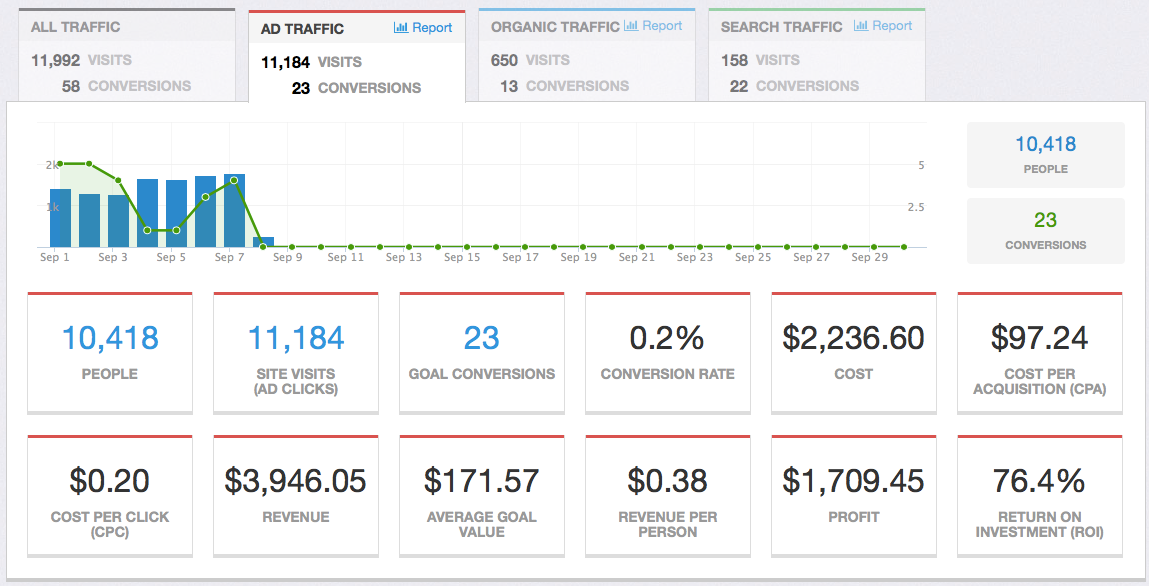
If sales do not take place on the initial visit and we collect email, we can then conduct Test 5.
Test 5: Email Nurture For Initial Sales
This screenshot shows a multi-variate test indicating a whopping 37.84% sales conversion rate (demonstrating the synergy of email nurture campaigns and multi-variate testing).
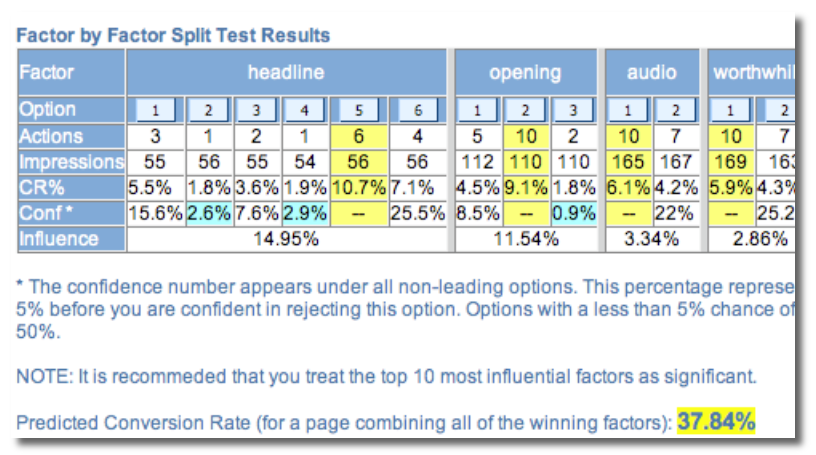
How could I possibly achieve a 37.84% sales conversion rate?
Because this was the third test campaign for this particular nurture funnel. Each cycle of optimization helping to maximize conversions. It was this test in 2006 that really opened my eyes to the value of diligent split testing.
As hall-of-fame copywriter Gene Schwartz remarked: “only the test decides”.
And finally, we can also test campaigns for repeat customer purchase.
Test 6: Repeat Customer Campaigns
As an ad agency copywriter in 2007 I wrote copy for dozens of agency clients and quickly hit my first major home run…
An email I wrote for the agency’s largest client account beat the best performer by 510%!
- Total list size 30k
- Average order value: 10k
- Expected enquiries based on past campaign performance: 0.05% = 15
- Expected sales conversion: 3% = 0 new customers (they got a customer once every several months from that particular promotion).
- Marketing costs = £2,000
For our test with my copy against the agencies existing best creative we split the list.
The agency’s email pulled in a respectable 10 new enquiries based on the 8 they expected from 15k names…
…while the new approach I took with the copy, based on traditional principles of direct response copywriting, pulled in a record breaking 61 enquiries.
And because of the highly personal nature and human appeal of my copy, the client soon closed two deals at approximately 10k each (a 20k return).
With marketing costs at 1k (half of the full cost of 2k given that we did a split test) that’s a direct campaign ROI of 1900%.
And of course they could continue to re-use the email I had written in future campaigns.
But this was only the beginning…
- I worked with the client on their prospect information pack to increase close rate following the new lead generation.
- I planned a follow-up series to the list of 15k that had received my email
- Plus another campaign to the 59 leads who responded to the first email but hadn’t yet converted.
- And my email was also scheduled for broadcast to the list of 15k that had not yet received it.
Conclusions?
Split testing your lead gen and sales funnel can bring demonstrably higher campaign performance — and opportunities for improvement are endless!
“Sure, But I Really Have Very Limited Time For Running Test Campaigns”
I know…
Having been in the marketing budget holders chair a number of times, I know how it feels to juggle between new high-leverage opportunities and sustaining existing profitable campaigns.
Despite the transformational power of split testing, it can take a lot of time and resources to create test variants and get the performance tracking working accurately throughout the funnel.
That’s why I created a flexible service to help alleviate the challenge of validating new campaign ideas before you go ahead with major roll-outs.
Check out the service description on www.cyclicmedia.com and hit me up if I can take on any test-and-learn projects for you as we forge ahead into the opportunities of a new year.
Happy 2016.
Shawn Shaw
Director, ITVibe
